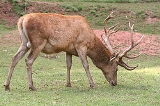
Red Deer
Overview
The red deer is one of the largest deer
species. Depending on taxonomy
, the red deer inhabits most of Europe, the Caucasus Mountains
region, Asia Minor
, parts of western Asia, and central Asia. It also inhabits the Atlas Mountains
region between Morocco
and Tunisia
in northwestern Africa, being the only species of deer to inhabit Africa. Red deer have been introduced to other areas including Australia
, New Zealand
and Argentina
. In many parts of the world the meat (venison
) from red deer is used as a food source.
Red deer are ruminant
s, characterized by an even number of toes, and a four-chambered stomach.
Genetic
evidence indicates that the red deer (Cervus elaphus) as traditionally defined is a species group
rather than a single species, although it remains disputed exactly how many species the group includes (see Taxonomy).
Deer
Deer are the ruminant mammals forming the family Cervidae. Species in the Cervidae family include white-tailed deer, elk, moose, red deer, reindeer, fallow deer, roe deer and chital. Male deer of all species and female reindeer grow and shed new antlers each year...
species. Depending on taxonomy
Taxonomy
Taxonomy is the science of identifying and naming species, and arranging them into a classification. The field of taxonomy, sometimes referred to as "biological taxonomy", revolves around the description and use of taxonomic units, known as taxa...
, the red deer inhabits most of Europe, the Caucasus Mountains
Caucasus Mountains
The Caucasus Mountains is a mountain system in Eurasia between the Black Sea and the Caspian Sea in the Caucasus region .The Caucasus Mountains includes:* the Greater Caucasus Mountain Range and* the Lesser Caucasus Mountains....
region, Asia Minor
Asia Minor
Asia Minor is a geographical location at the westernmost protrusion of Asia, also called Anatolia, and corresponds to the western two thirds of the Asian part of Turkey...
, parts of western Asia, and central Asia. It also inhabits the Atlas Mountains
Atlas Mountains
The Atlas Mountains is a mountain range across a northern stretch of Africa extending about through Morocco, Algeria, and Tunisia. The highest peak is Toubkal, with an elevation of in southwestern Morocco. The Atlas ranges separate the Mediterranean and Atlantic coastlines from the Sahara Desert...
region between Morocco
Morocco
Morocco , officially the Kingdom of Morocco , is a country located in North Africa. It has a population of more than 32 million and an area of 710,850 km², and also primarily administers the disputed region of the Western Sahara...
and Tunisia
Tunisia
Tunisia , officially the Tunisian RepublicThe long name of Tunisia in other languages used in the country is: , is the northernmost country in Africa. It is a Maghreb country and is bordered by Algeria to the west, Libya to the southeast, and the Mediterranean Sea to the north and east. Its area...
in northwestern Africa, being the only species of deer to inhabit Africa. Red deer have been introduced to other areas including Australia
Australia
Australia , officially the Commonwealth of Australia, is a country in the Southern Hemisphere comprising the mainland of the Australian continent, the island of Tasmania, and numerous smaller islands in the Indian and Pacific Oceans. It is the world's sixth-largest country by total area...
, New Zealand
New Zealand
New Zealand is an island country in the south-western Pacific Ocean comprising two main landmasses and numerous smaller islands. The country is situated some east of Australia across the Tasman Sea, and roughly south of the Pacific island nations of New Caledonia, Fiji, and Tonga...
and Argentina
Argentina
Argentina , officially the Argentine Republic , is the second largest country in South America by land area, after Brazil. It is constituted as a federation of 23 provinces and an autonomous city, Buenos Aires...
. In many parts of the world the meat (venison
Venison
Venison is the meat of a game animal, especially a deer but also other animals such as antelope, wild boar, etc.-Etymology:The word derives from the Latin vēnor...
) from red deer is used as a food source.
Red deer are ruminant
Ruminant
A ruminant is a mammal of the order Artiodactyla that digests plant-based food by initially softening it within the animal's first compartment of the stomach, principally through bacterial actions, then regurgitating the semi-digested mass, now known as cud, and chewing it again...
s, characterized by an even number of toes, and a four-chambered stomach.
Genetic
Genetics
Genetics , a discipline of biology, is the science of genes, heredity, and variation in living organisms....
evidence indicates that the red deer (Cervus elaphus) as traditionally defined is a species group
Species group
A species group is an informal taxonomic rank into which an assemblage of closely related species within a genus are grouped because of their morphological similarities and their identity as a biological unit with a single monophyletic origin.-Use:...
rather than a single species, although it remains disputed exactly how many species the group includes (see Taxonomy).
Unanswered Questions

